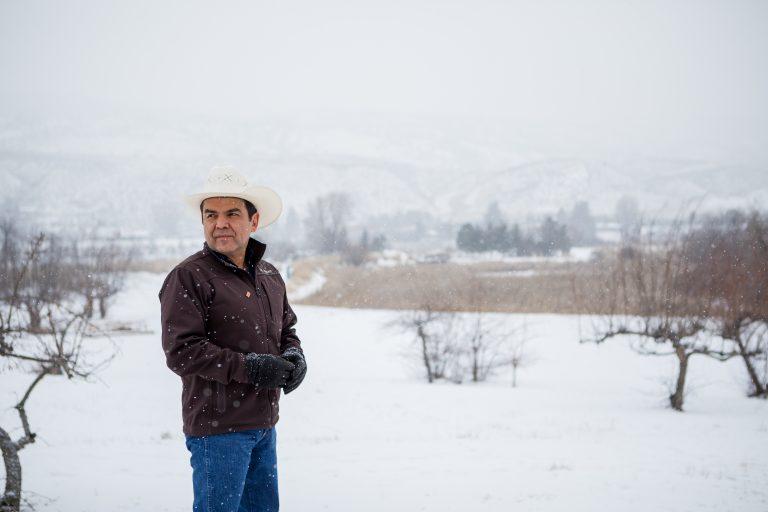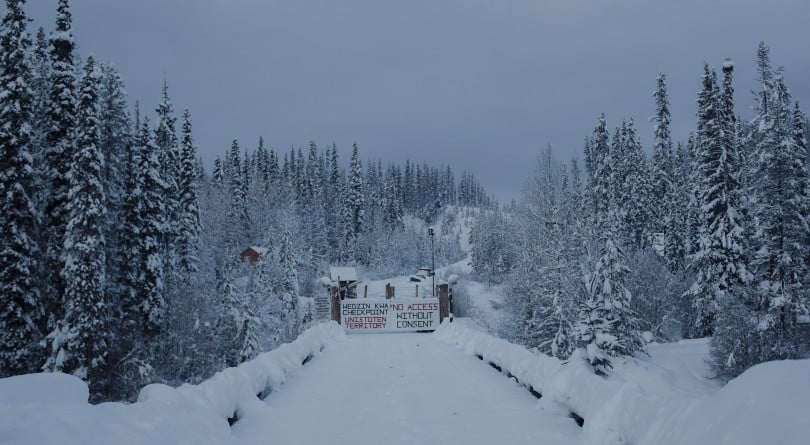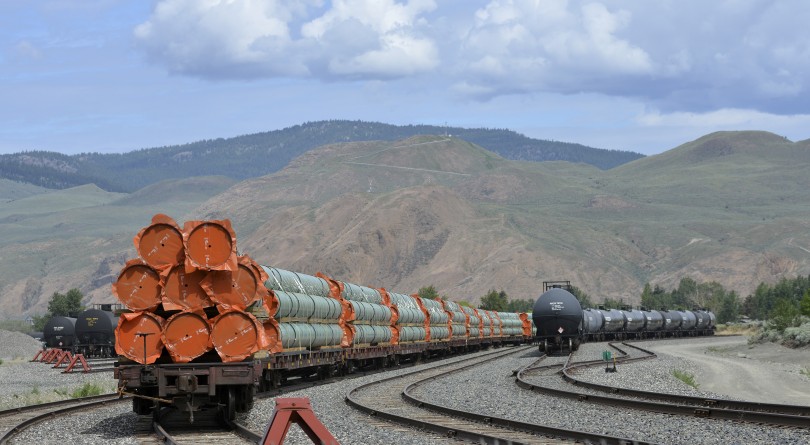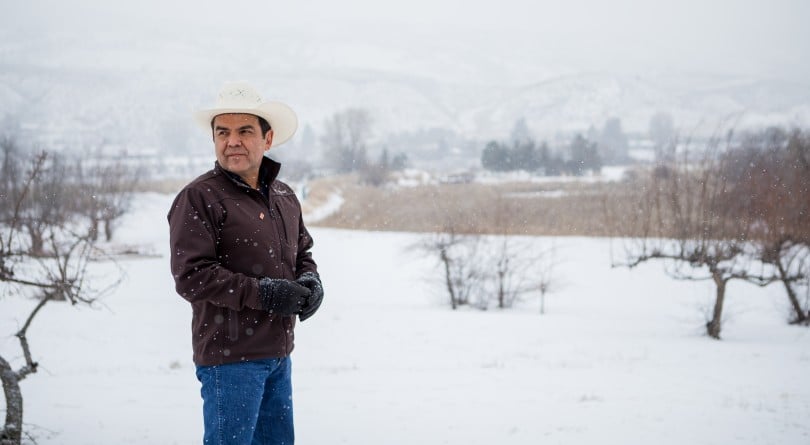High price of buying in: Oil-friendly Indigenous groups are disparaged as ‘sellouts’
Bands in Alberta and B.C. want in on energy infrastructure to reap the economic benefits—and to implement environmental protections

Chief Michael LeBourdais in Kamloops, B.C. (Photograph by Kathleen Fisher)
Share

Not long ago, Stephen Buffalo, the president and CEO of the Indian Resource Council of Canada (IRC), held a conference called “Pipeline Gridlock” in Calgary to discuss the involvement of Indigenous people in natural resource projects. Invitations went out to its 174 First Nation members and prominent oil executives. The year was 2016. Enbridge’s Northern Gateway was months away from being killed and the Trans Mountain expansion was better known as TMX. Fort McMurray, Alta., had partly burned. At the time, Buffalo got word that environmental groups and the Idle No More movement would converge on the streets in protest; Greenpeace had sectioned off a part of the city. So Buffalo put off the conference until later that year. But he still remembers what was said about him: “sellout Indian.” “Earth killer.”
Time ground on, and these days Buffalo is used to it. “I used to take it personally,” he says, adding, “I played hockey in Alberta—my skin is pretty thick.” It comes with the job. Buffalo oversees an organization that’s been advocating for oil-and-gas-producing First Nations since the 1980s. In 2016-17, there were 35 of them producing oil and 51 harnessing natural gas, according to Indian Oil and Gas Canada, a federal agency within Crown-Indigenous Relations and Northern Affairs Canada. Buffalo put together another meeting in January, this time at the Grey Eagle Resort and Casino on the outskirts of Calgary. There, leaders from dozens of First Nations came together with a more ambitious goal—one that would give them a stake in a project that other Indigenous groups went to court to halt: to purchase the Trans Mountain pipeline. Pipelines, and the civic battles that surround them, have come to define Justin Trudeau’s increasingly fraught relationship with First Nations. Indigenous groups resolutely fought both the Northern Gateway and Keystone XL, helping seal the fates of both of those unrealized projects. Tensions escalated further in January, when the RCMP dismantled a fortified encampment held by a clan of the Wet’suwet’en Nation in northwestern B.C., who sought to prevent construction workers from building a gas pipeline on their traditional territory. Though that project falls under provincial jurisdiction, many Indigenous people see the controversy as a result of Ottawa’s failure to resolve their land claims and meaningfully consult with leaders who govern traditional territories. (The involvement of the Mounties—long the face of state force against Indigenous resistance—didn’t help.)
Through it all, the dominant narrative in news coverage of these confrontations has painted First Nations as one homogeneous group sharing values, beliefs and opposition toward oil and gas projects. But lately, another version has been quietly gaining momentum. Over the past decade, more and more bands in Alberta and B.C. have been vying for a stake in energy infrastructure as a means to reap the economic benefits but also, they say, to take control over environmental protections to ensure the projects don’t harm their lands.
READ: The Trans Mountain expansion will struggle for years—even if it gets the green light in 2019
At the January meeting, the chiefs aligned with Buffalo discussed financing options that would require investments in the billions. He declines to provide specifics, but says several pension funds have approached the group out of curiosity, adding: “I don’t think there’s a shortage of Canadian money.” Nor does he give an exact number for the First Nations eager to make a bid, though unifying them appears to be the challenge: Buffalo uses the word “factions” to describe the groups of leaders who have come forward. “Our take was, ‘Definitely, we need a pipeline,’ ” he says. “But we need consensus; we need to come together.”
Last year, the Federal Court of Appeal harshly criticized and quashed Ottawa’s approval of the Trans Mountain expansion, which would have twinned an older pipeline linking Edmonton and Burnaby, B.C. The fallout ensued in rapid order. The previous owner, Kinder Morgan, announced it wanted out of the expansion, leaving Ottawa to purchase the pipeline for $4.5 billion. But the feds let it be known they would want to eventually sell the contentious project once they’d revamped their consultation process and received the required approvals.

For the Indigenous groups and communities that fought fervently to prevent the pipeline from being built, the court’s ruling was a monumental victory. But there are about 120 Alberta and B.C. First Nations along the Trans Mountain corridor, and more than 40 of them have signed or accepted highly lucrative mutual benefit agreements with Kinder Morgan. And the behind-the-scenes machinations since then point to an alternative view—one where ownership of big-ticket resource projects can help realize the unfulfilled aspirations of Indigenous communities.
“Some of our people are asking for sovereignty,” says Buffalo. “You can’t get sovereignty if you’re still accepting government money under the Indian Act. This is our way of trying to address those [development] issues. We need that same opportunity as any other Canadian.” Buffalo is from the Samson Cree Nation south of Edmonton and when he was growing up, his community benefited financially from its oil and gas assets. When he left home for university, he recalls visiting other First Nations throughout the province that were less fortunate and struggled from the various ailments that plague so many Indigenous communities.
READ: How the Trans Mountain pipeline became a political dumpster fire
Buffalo hopes his group can present its bid before this fall’s federal election. But at this point, he isn’t sure whether the federal government considers them seriously as a potential bidder (he says Natural Resources Minister Amarjeet Sohi did not acknowledge the IRC’s invitation to the meeting in January), but officials haven’t exactly come out saying no, either. And they would have recent examples to follow. In 2017, the Mikisew Cree and Fort McKay First Nations in Alberta purchased 49 per cent of Suncor’s East Tank Farm Development north of Fort McMurray for $503 million. Fort McKay Chief Jim Boucher—named the 2018 “Canadian Energy Person of the Year” by the Energy Council of Canada*—triumphantly called it the “largest business investment to date by a First Nation.”
Fort McKay is a case study of what can happen to a community that chooses to embrace the oil sands and withstand the fierce debate that comes with it. Its unemployment rate is nearly zero. Its members earn an average income of $78,916, as of 2015. Its financial holdings exceed $2 billion. Between 2012 and 2016, government transfers accounted for only five per cent of its total revenue. “Not every community can have a casino,” says Buffalo dryly. “We have to work with what’s around us.”
Buffalo would be content with owning just a piece of the pipeline’s equity. He points to a deal made in 2018 between the Ontario government and 129 First Nations as a plausible route that could be applied to the case of Trans Mountain. The communities purchased more than 14 million shares—a 2.4 per cent ownership stake—of Hydro One, an arrangement that was financed through a loan from the government of former Ontario premier Kathleen Wynne. The province’s energy ministry framed it as “Ontario’s journey of healing and reconciliation with Indigenous peoples.” Crosbie & Company, an advisory firm in Toronto, helped negotiate the purchase, and sources have told Maclean’s that the company has met with interested First Nation parties about Trans Mountain.
But there’s still staunch opposition on the pipeline. Some of the strongest comes from the Neskonlith band (belonging to the Secwépemc Nation, which comprises 17 bands) in the B.C. interior. The community has repeatedly voiced concerns over the looming threat of oil spills and the negative impact of increased tanker traffic on marine life, as well as the effect on their own traditional ways of living.
Judy Wilson, who is kukpi7 (chief) of the Neskonlith band, says it doesn’t matter who owns Trans Mountain; her people will remain against it. She questions the wisdom of the investment that Buffalo and his group would be making, given the project needs renewed regulatory approvals before shovels can break the ground and the protests it will inevitably face. But she isn’t surprised so many want a stake, saying: “Many of our communities live below the poverty line.”
In Wilson’s mind, the idea of Indigenous ownership is another attempt by Ottawa to “dangle a carrot” with false promises. Many of the jobs the expansion is expected to provide, she stresses, will be temporary, and the economy itself unsustainable. She suspects there’s something more sinister at play. “It’s been divide-and-conquer tactics all along in regards to Trans Mountain,” she says.
Buffalo says he’s alive to the tension that exists between First Nations. But he takes issue with certain environmental organizations, which he says distort the facts to suggest pro-pipeline Indigenous groups are being bought off, adding that “everybody wants a clean environment, as do we. We do not want environmental catastrophes to happen. We have to find a safe way.” One way, he says, is to replace older pipelines with newer ones that are less susceptible to breakage and human error.

If the Trans Mountain expansion does get built, its path would slice through lands of the Whispering Pines/Clinton Indian band, a Secwépemc community just north of Kamloops, B.C., passing about 100 m from the house of Chief Michael LeBourdais’s sister. LeBourdais has been a vocal leader in the push to purchase the pipeline, having formally discussed the idea with more than 20 First Nations (he says there’s even more interest from communities not precisely on the pipeline’s route). He has wanted a cut of the equity ever since he started speaking to Kinder Morgan’s CEO Ian Anderson in 2012.
Economics is one reason, he says, “but more important is the ability to direct environmental oversight into operations.” The 180 people of Whispering Pines strongly support the pipeline, LeBourdais says. It’s a place from which locals—many of them already employed by the energy industry—travel far and wide for work, and see the prospect of work and income from the Trans Mountain expansion as an opportunity to come home. Many lost their jobs after a local logging operation the community relied on shut down in 2016 because of mismanagement. “Do you see anybody lining up to buy this thing?” LeBourdais asks wryly. “Just the Indians.”
LeBourdais says he’s met with groups of investors in Calgary, Kamloops and Vancouver, though he wouldn’t name names. He doesn’t believe Ottawa would want to go into the next federal election having not sold the pipeline. “For us, it’s a drag race,” he says. “Sooner the better. So I can get on with riding horses and doing other things.”

LeBourdais got an early start on the Trans Mountain initiative. He met with Finance Minister Bill Morneau in Ottawa on a couple of occasions, the first meeting coming soon after the government made the purchase in 2018. “Just to let him know what we’re trying to accomplish,” he says. “We said, ‘This is what we’re trying to do.’ Then he said, ‘Slow down there, fella.’ He’s a nice guy.” (Morneau’s office did not comment.)
And the chief is comfortable with the environmental hazards of having a pipeline run through his community, saying he’s confident the risks can be mitigated. The way he sees it, Indigenous communities will likely become part of more energy projects, and that won’t please a lot of people. “I don’t know why people think First Nations are homogeneous and we should all agree on the same things all the time—that never happens at the House of Commons,” he says.
Buffalo, too, hears the ecological concerns—especially the lingering fears of a spill. But to him, the economic benefits outweigh that trepidation. He justifies his motivations with the same argument as those fighting to block the pipeline: he’s thinking of future generations. “Our shareholders in our communities aren’t born yet,” he says.
For now, Buffalo’s stuck, as he puts it, trying to “herd the cats” who lead pipeline-friendly First Nations. But he takes solace knowing that his organization is receiving support from the industry and nods of approval from Alberta, two things that haven’t always happened in the past. He knows it could be game-changing in a historical sense for Indigenous peoples, and quite possibly narrative-altering. “My worst fear is that this opportunity is going to go by,” he says, “and we’ll be standing there left with nothing.”
CORRECTION, March 14, 2019: An earlier version of this story misstated the name of the organization that hands out the Energy Council of Canada’s Canadian Energy Person of the Year award.
MORE ABOUT TRANS MOUNTAIN PIPELINE:
- It’s time to leverage Canada’s energy advantage into a geopolitical one, too
- How the Trans Mountain pipeline became a political dumpster fire
- Respect for First Nations rights could’ve spared us this panic over Trans Mountain
- The Liberals own the Trans Mountain court loss as surely as they own the pipeline